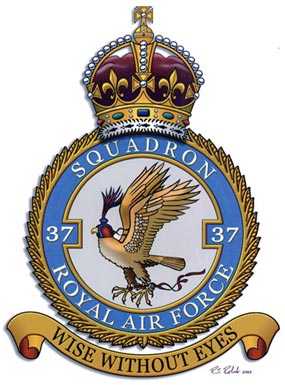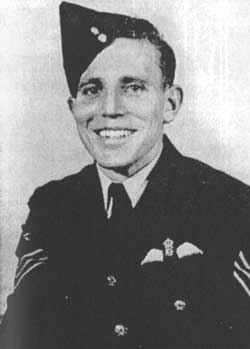37 SQUADRON OPERATIONS - TORTORELLA, ITALY 1944
Now here’s W/O MacIsaac, he’s on ops tonight.Swinging down the runway in someone else’s kite.
He’ll shoot the shit when he gets back,
Of how he bombed through ten-tenths flak.
It’s dicey flying Wimpys around Italian skies.
(From the "Wimpy Song", sung by crews to the tune of "Lili Marlene")
Upon joining an operational unit it was common practice for pilots to fly one or more operations as "2nd Pilot" (or "second dickey" in the slang of the day) with an experienced crew before taking their own aircraft and crew over a target. For most pilots this was their first experience in actual combat over a defended target.
|
|
On his first two ops as "second dickey" Pilot Maurice Lihou of No. 37 Squadron found himself on "dry runs" - the first target was undefended and the second op was abandoned due to 10/10ths cloud over the target zone. He was fairly lucky on his third and final flight as 2nd Pilot also, as it was only lightly defended. Still, his first experience over a "real" target left an indelible impression. Lihou recalled that operation, flown on March 15, 1944 against the marshalling yards at Sofia, Bulgaria:
[After crossing the Adriatic] ... eventually we made landfall at Mount Cherni and there, unexpectedly, in the valley below, out of the darkness of the mountain range lay Sofia, completely unprepared and with no apparent blackout. The city was lit up in all its glory. The scene that greeted me, for which I was completely unprepared, was that of a fairy city aglow by a thousand and one lights set in a backcloth of snow. It reminded me of a scene on a Christmas card, or of a giant birthday cake lit by a thousand candles. It was as if the whole city was on a night out enjoying the music of Strauss. It looked enchanted. Furthermore, to add to its enchantment, the snow reflected the shimmering lights up on to the dark, black clouds above. It was like a chandelier in the sky; the whole picture laid out in front of me was beautifully serene, wonderfully calm and peaceful.
We gazed at the sight ahead in wonderment, but the drone of the engines and the black shapes of the bombers around us served to remind us of the awesome task that lay before us. Our job would be to shatter that peaceful scene.
Below the ground defenses were obviously taken by surprise because, all of a sudden, the lights went out. They must be in a panic down there I thought. That must have thrown everyone into confusion. Searchlights came on, lighting up the sky in place of the city’s lights, and we saw fingering beams of light in all directions. These were augmented by one or two bursts of light flak, spattering and crackling orange bursts of fire, like rockets in the sky on firework night. Then there was the odd burst of red tracer coming straight up from the ground and curving away harmlessly.
"They know we are around,’ I said.
"But they don’t seem to know where we are," replied the Skipper. "They probably think we are Russians."
Then, astonishingly, as quickly as the lights of the city had gone out, they came on again. They stayed on for a few minutes, and then off they went again. They really must be in a panic, I thought as we flew on relentlessly. I could imagine people below running about in all directions, like a scene out of the H.G. Wells film, Things to Come.
The beams from the searchlights wandered aimlessly about the sky. Flares from the attacking force lit up the target area and at 11,000 feet the bombing run commenced onto the marshalling yards. Flak was bursting below, light in intensity and not very accurate. I was fascinated. I could clearly see the target ahead: railway lines running into it then intersecting and crisscrossing each other, with engine sheds and numerous other buildings dotted around. There were long straight roads leading into the yards, with blocks of buildings intersected by streets fanning out from them. I could clearly see what I thought looked like a river or canal running close by, with boats or barges on it. It appeared to be five or six blocks away.
Whatever it was, it had long, clear boulevards running either side of it with bridges going across it. It was the first major target I had ever seen and I was enthralled. The bomb aimer steered the skipper towards it. "Steady, left, left, right a bit, hold it there," came the instructions over the intercom. "Bombs gone."
The bombs were dropped in one stick and bursts were seen in the target area. The pilot broke off his attack, but stayed on course for thirteen seconds to take the photographs. Turning for home, I felt a little disappointed. I would have loved to have gone around again to see more. That had been a real target compared to the other two ops I had been on, and I had thoroughly enjoyed the experience. [Interestingly this reaction was common among new crews - it would change quickly as they had more terrifying experiences and learned how many crews failed to return.]
Of the thirteen Wimpys which took off, two abandoned the task owing to faulty airspeed indicators and the remainder, including the illuminator, bombed the target from 0122 to 0137 hours from between 10,500 to 13,000 feet under good illumination. Two 4,000 pound bombs and seventy two 500 pound bombs were dropped. Bombing was reported to have covered the target area, several sticks being seen to burst across the yards and buildings to the south. Two fires were reported burning in the area. Nearly 18,000 leaflets were dropped, telling the inhabitants that they were no longer safe from attack and to overthrow their leaders. The weather was bad en route and, on the return journey, was so bad that the crew of the aircraft captained by the Commanding Officer baled out and one aircraft landed away from base. Fortunately, all crews returned safely to the squadron. The weather closed in and it was a further six days before the squadron was able to operate again.
That was my last op as second pilot; the next I would be with my own crew.


